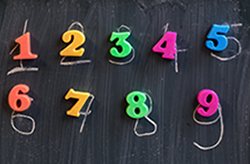The Five Areas of Early Math
Children’s early math learning happens across five areas: Numeracy, Operations, Geometry and Spatial Sense, Patterning, and Measurement. In each area, there is a cluster of skills children are working on, which follow a sequence or developmental path that children travel to achieve those skills.

Numeracy
Numeracy is our ability to understand and work with numbers. As adults, it’s a skill we use every day to do things like pay a bill, count objects, and compare prices. Developing an understanding of numbers is one of the major mathematical tasks for children in early childhood. Numbers provide us with a way to describe the world around us, and numeracy skills set the foundation for skills in almost every other area of early math. The area of numeracy is about understanding that numbers represent quantities and have ordinal properties. For example, that numbers can be arranged in order of magnitude from smaller to larger, and can be compared. Four key numeracy skills are explored as part of STEP:
- Subitizing
- Counting and Cardinality
- Comparing and Ordering Numbers
- Recognizing and Writing Numerals

Operations
Operations is all about using number knowledge to solve basic mathematics problems. In preschool, when we talk about operations, we’re not working with formal symbols yet (so addition and subtraction problem with the + - =). For young children, these concepts are explored with either small numbers or concrete objects, like snap cubes or counters, that they can manipulate. STEP focuses on two key skills:
- Adding and Subtracting
- Sharing Fairly

Geometry and Spatial Sense
In preschool, geometry and spatial sense is about helping children discover shapes and space. Geometry is about helping children recognize shapes and understand their properties. It’s not just about identifying shapes in an isolated way, but really seeing how they connect to the physical world we live in. Spatial sense is about helping children develop an understanding of an object’s position and its relation to other objects. STEP explores two key skills:
- Shape Recognition and Properties
- Directionality, Order, and Position

Patterning
In preschool, young children are learning how to recognize and fill in the missing elements of a pattern. They are also working on duplicating and extending simple patterns, and even creating their own. This area focuses on one key skill:
- Duplicating, Extending, and Creating Patterns

Measurement
When children compare the length of two sticks, think about which piece of paper will allow them to draw the biggest picture, or decide which container holds more jelly beans, they are using measurement. At its core, measuring is about assigning a number to an object’s attribute, such as its length, area, volume, or weight. This area focuses on two skills that help young children develop an understanding of measurement:
- Describing and Comparing
- Measuring

